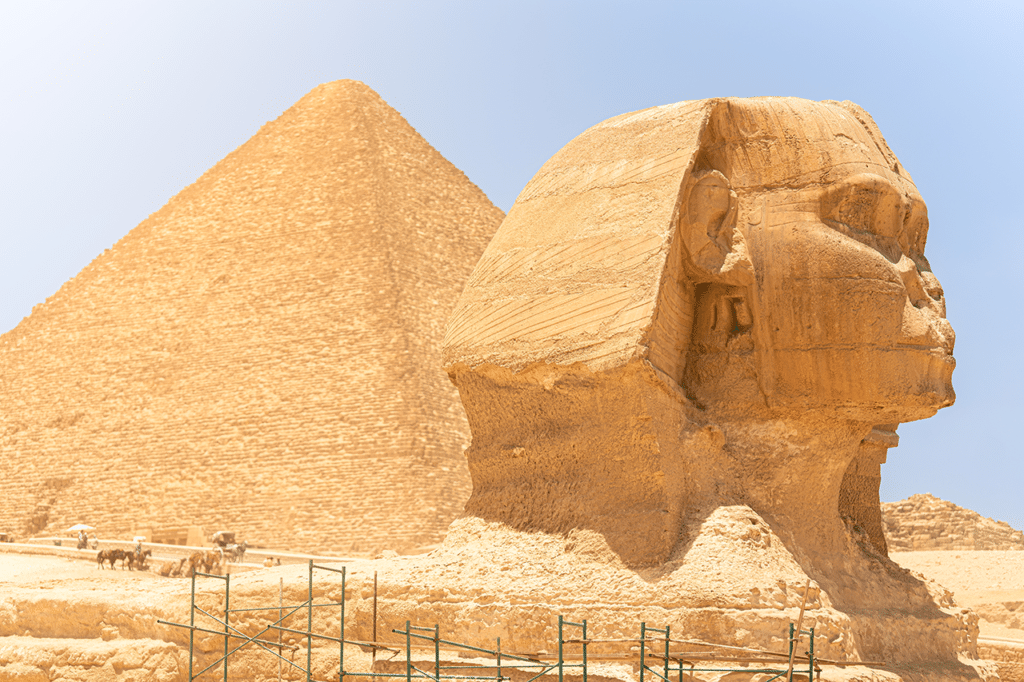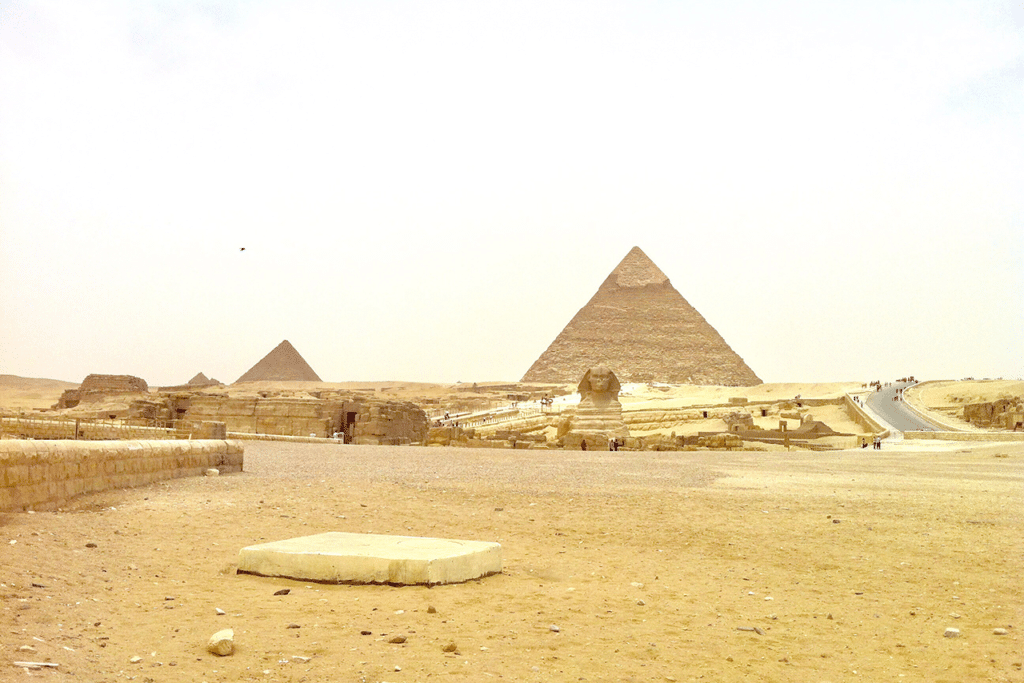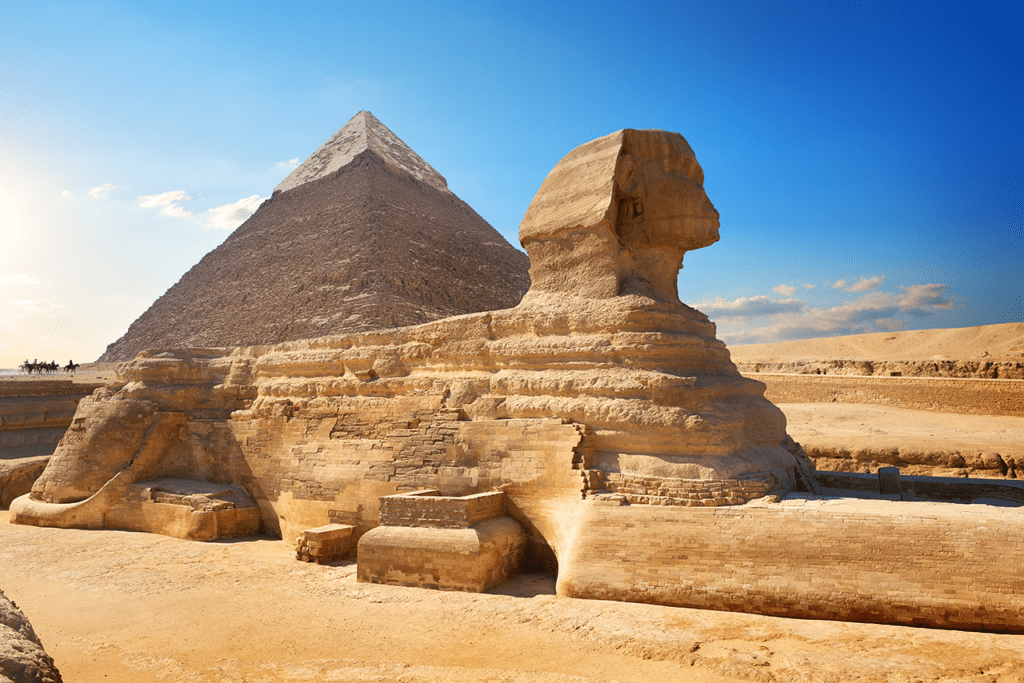The Mysteries of the Sphinx have been captivating human imagination since time immemorial. People have speculated about its age, purpose, and origin for centuries. The Sphinx, located in Giza, Egypt, is one of the world’s most famous and enigmatic ancient structures. The massive statue depicting a lion with a human head has puzzled scholars and researchers for centuries, with many theories and debates surrounding its origins, purpose, and meaning.
One of the main mysteries of the Sphinx is its age. While most experts agree that the Sphinx was built during the reign of the pharaoh Khafre, who ruled Egypt around 2500 BCE, some theories suggest that the statue may be much older. Some researchers have proposed that the Sphinx predates the ancient Egyptian civilization and may have been built by a lost civilization or extraterrestrial beings. Recently, a new theory emerged after revisionist Egyptologists Hancock and Bauval conducted a rigorous investigation into the Sphinx and its relation to the other monuments of the Giza Plateau.
At first glance, it appears that the Great Sphinx is only 4500 years old – a figure that has been accepted by the archaeological community for centuries. However, recent geological evidence suggests this might not be the case. The erosion patterns on the flanks of the Sphinx were caused by 1000 years of heavy rain – conditions last experienced in Egypt during the end of the last ice age (10-9 thousand BC). If their theory is correct, then the Sphinx could be thousands of years older than previously thought.
This would certainly explain why no records exist documenting who built it or why they chose to do so. Moreover, this evidence supports Hancock and Bauval’s theory that an even more ancient civilization was responsible for constructing it – one predating known Egyptian history by several millennia.

This civilization was likely aware of celestial cycles much like those observed by modern astronomers today: when viewed from certain angles in relation to each other, some of these monuments create alignments with certain stars or planets – most notably Orion’s belt or Sirius – hinting at a deep understanding of astronomy unknown to our ancestors living just 4500 years ago.
This begs an obvious question: did these unknown architects possess advanced knowledge, or was their exact construction simply due to luck? Did they randomly stumble across these alignments as they constructed their monuments? Or were they guided by something else?
The truth may never be known, but one thing is certain: until we can answer these questions with certainty, curiosity will always surround The Great Sphinx and its mysterious origins.
Unlocking the Mystery of the Sphinx: Exploring Its Ancient Purpose
The Great Sphinx of Giza is a mysterious and awe-inspiring monument that has captivated visitors for centuries. The monolith stands guard at the entrance to the Giza Plateau, which is home to several ancient Egyptian pyramids. Despite being one of the most recognized symbols of Egypt, its true purpose remains a subject of debate among scholars. While some theories suggest that it was built as a tribute to Pharaoh Khafre or as an astrological symbol, recent research presented by authors Robert Bauval and Graham Hancock may have uncovered its true purpose.
Their research suggests that the Sphinx and associated causeways and alignments were part of a large-scale effort to record in stone the celestial array at the vernal equinox in 10,500 B.C., which they refer to as Zep Tepi (the “First Time”). This moment appears to be referenced in hieroglyphic records. It seems to have been revered by ancient Egyptians who sought to replicate this sacred journey on Earth through initiation rituals undergone by pharaohs. They propose that treating the Giza Plateau as a template of this same ancient sky could help us locate what they refer to as a “Hall of Records” belonging to a lost civilization found beneath the plateau.
These theories may seem outlandish, but aspects of them are supported by archaeological evidence. For example, it has been suggested that an alignment between stars in Orion’s Belt and three particular pyramids at Giza deliberately echoes the arrangement seen in 10,500 BC during Zep Tepi. Additionally, several hieroglyphic inscriptions near statues of pharaohs indicate that those rulers were somehow connected with star constellations such as Orion’s belt or Sirius—connections which would make sense if these objects served some astronomical purpose related to Zep Tepi.

The possibility that ancient Egyptians were able to build monuments based on astronomical observations hints at their advanced understanding of astronomy and engineering—an understanding which may have enabled them to perform calculations even more complex than those needed for accurate alignments between stars and structures (such as determining when certain events would occur). If this theory is correct, then examining why they chose Zep Tepi as an important moment to commemorate would draw us closer to uncovering the secrets behind this awe-inspiring monument. Furthermore, exploring how modern technologies can help us analyze existing evidence to search for new insights might illuminate our understanding of why this period was chosen for commemoration.
This theory is bolstered by studies that suggest that at certain times throughout the year, sunlight filters into special chambers inside the Sphinx through precisely placed windows – an effect known as “zodiacal light” – allowing for astronomic observations such as star alignments or planetary conjunctions to be made. It’s also possible that these observations were used to track holidays or festivals related to celestial events.
In addition, some researchers suggest there may be hidden chambers located beneath the Sphinx which hold ancient records detailing far-reaching secrets related to lost civilizations; however, no solid evidence has yet been found supporting this claim.
On top of all this speculation, more recent research has suggested that due to certain geological features found around the Giza complex, including a former lagoon-like basin near where the Sphinx now stands, many believe there may have been an even earlier version of this statue before Khafra’s time – possibly dating back 5000 BC!
Regardless of its exact origins or purpose, everyone can agree on just how mesmerizingly beautiful this massive sculpture truly is – an undeniable testament that continues to capture our imaginations centuries later!
Another mystery surrounding the Sphinx is its purpose. Many experts believe that the statue was built to symbolize the pharaoh’s power and authority as a guardian of the nearby royal tombs. However, some theories suggest that the Sphinx may have had a more spiritual or religious significance and may have been used for ceremonial or ritualistic purposes.
The Sphinx’s appearance also raises questions. Some researchers believe that the statue’s human head may depict Khafre himself, while others propose that it may depict a god or goddess. The exact meaning and symbolism of the statue’s features and proportions remain a subject of ongoing debate.

The Sphinx also has a series of underground chambers, which are believed to have been used for various purposes, such as tombs, temples, or storage. These chambers remain largely unexplored, and many experts believe they may contain important clues about the Sphinx’s origins and purpose.
Do you think the Sphinx has more secrets to share?
Despite centuries of study and research, many aspects of the statue’s origins, purpose, and meaning remain unclear. The Sphinx’s age, for example, is a subject of ongoing debate, with some experts suggesting that the statue may be much older than commonly believed. The purpose of the Sphinx is also not specific; some experts believe that the statue may have had a more spiritual or religious significance and may have been used for ceremonial or ritualistic purposes. The meaning and symbolism of the statue’s features and proportions are not fully understood.
The underground chambers located beneath the Sphinx also add to the mystery of the Sphinx, as they remain largely unexplored and may contain important information about the Sphinx’s history and significance. In addition, many theories about the Sphinx that propose that the statue is much older than commonly believed or built by extraterrestrial beings are considered fringe and not supported by mainstream Egyptologists and archaeologists.
The great Sphinx of Giza continues to be one of the world’s most enduring mysteries, filled with tales and legends that still captivate people from all walks of life. No matter its actual purpose, the Sphinx stands tall as a testament to ancient Egypt and its culture, inspiring us with its sheer mystery and majesty. Like the sands of time, its secrets are buried beneath layers of history and dust – yet somehow managing to stay alive in our collective memories and imaginations. For generations, the Sphinx has been a beacon of exploration and adventure, calling out to intrepid travelers everywhere – inviting them to stare into its enigmatic eyes and dare to unravel its long-forgotten riddles.
